DISCLOSURE: Most of our content uses affiliate links. As an Amazon Associate, we may earn a commission when you buy through the links. Each of your purchases via our affiliation links helps us to support the cost and maintenance of this site.
So, you’re stepping into the exciting world of podcasting! You’ve got brilliant ideas, a captivating voice, and a burning desire to share your message with the world. But there’s one crucial piece of equipment that can make or break your podcasting journey: the microphone.
The process of choosing the ideal microphone might seem a bit daunting. A quick search online throws up a dizzying array of options, each promising “studio-quality sound” and “crystal-clear audio.” But what does it all mean? What actually matters when you’re looking for the best microphone to capture your voice and bring your podcast to life?
Don’t worry, you’re not alone in feeling a bit lost. I’ve been there too! In this guide, we’ve done the hard work for you, and I’m going to break down the best podcasting microphones for high-quality audio, not just from a technical standpoint but also from a practical perspective. We’ll help you figure out which microphone is best for your podcasting needs and budget by going over the different types and breaking down the terms.
Why Your Microphone Matters More Than You Think
Think of your microphone as the bridge between your voice and your listeners. A good microphone captures the nuances of your voice, helping you sound clear, engaging, and professional. It’s the difference between a podcast that people want to listen to and one that gets lost in the noise.
A poor-quality microphone can bring in annoying background noise, create distortion, and make everything sound pretty muffled. It can turn even the most engaging content into something that feels a bit unpolished, making it harder for you to really connect with your audience.
Investing in a decent microphone is one of the smartest moves you can make as a podcaster. It’s an investment in your voice, your message, and your podcast’s potential.
The Two Main Microphone Types: Dynamic vs. Condenser
When you start researching podcasting microphones, you’ll quickly encounter two main types: dynamic and condenser. These terms refer to the way the microphone converts sound waves into electrical signals. Every type comes with its own set of strengths and weaknesses, which makes them more fitting for various recording environments and vocal styles.
 Dynamic Microphones (The Workhorses of Podcasting)
Dynamic Microphones (The Workhorses of Podcasting)
Dynamic microphones are like the trusty workhorses in the audio scene. They’re robust, durable, and less sensitive to loud sounds. Let me give you a quick overview:
How They Work
Dynamic microphones use a moving coil diaphragm attached to a magnet. When sound waves hit the diaphragm, it vibrates, moving the coil within the magnetic field. This movement generates an electrical signal that represents the sound.
Benefits:
-
-
-
- Durability: Dynamic mics are built to withstand rough handling and are less susceptible to damage from moisture or temperature changes.
- Less Sensitive to Background Noise: Because they have lower sensitivity, they’re perfect for recording in places that aren’t exactly soundproof, like a home studio with a bit of background noise.
- Handle Loud Sounds Well: They can handle a lot of sound pressure without warping, which makes them ideal for people who give a lot of speeches or record music with their podcasts.
- Generally More Affordable: Dynamic microphones tend to be more budget-friendly than condenser microphones.
-
-
Drawbacks:
-
-
-
- Less Detailed Sound: While they capture sound accurately, they might not pick up the subtle nuances of your voice as well as condenser microphones.
- Not Ideal for Capturing High Frequencies: They might not be the best choice if you’re aiming for a super-bright and airy vocal sound.
-
-
Who Should Use a Dynamic Microphone?
Beginner Podcasters
They are an excellent place to start because of their price, robustness, and simplicity of usage.
Podcasters in Untreated Rooms
If you’re recording in a room with some background noise, a dynamic microphone can help minimize those distractions.
Podcasters with Loud Voices
If you tend to speak loudly or passionately, a dynamic microphone can handle your vocal power without distorting.
Podcasters on a Budget
You can find excellent dynamic microphones at very reasonable prices.
Most Popular Dynamic Microphones
Shure SM7B
A legendary microphone used by countless podcasters and broadcasters. Known for its warm, rich sound and excellent noise rejection. A bit pricier but considered a worthwhile investment.
Rode PodMic
A more affordable option specifically designed for podcasting. Delivers a clear, focused sound and is built like a tank.
Shure SM58 Pro
An industry-standard microphone for live vocals, but it also works well for podcasting. Extremely durable and affordable.
 Condenser Microphones (Capturing Every Nuance)
Condenser Microphones (Capturing Every Nuance)
Condenser microphones are known for their sensitivity and ability to capture a wider range of frequencies, resulting in a more detailed and nuanced sound.
How They Work
Condenser microphones use a thin, conductive diaphragm placed close to a metal backplate. When sound waves hit the diaphragm, the distance between the diaphragm and the backplate changes, altering the capacitance and creating an electrical signal. They require external power (phantom power) to operate.
Benefits:
-
-
-
- Highly Sensitive: They pick up even the subtlest details in your voice, resulting in a richer, more natural sound.
- Wider Frequency Response: They capture a broader range of frequencies, from deep lows to sparkling highs, adding clarity and presence to your voice.
- Excellent for Studio Recording: Their sensitivity and detail make them ideal for controlled recording environments.
-
-
Drawbacks:
-
-
-
- More Fragile: Condenser microphones are more delicate than dynamic microphones and can be damaged by rough handling or exposure to extreme conditions.
- Sensitive to Background Noise: They can pick up unwanted sounds like room echo, air conditioning hums, or even distant traffic.
- Requires Phantom Power: You’ll need an audio interface or mixer that provides phantom power to use a condenser microphone.
- Generally More Expensive: Condenser microphones tend to be pricier than dynamic microphones.
-
-
Who Should Use a Condenser Microphone?
Podcasters in Treated Rooms
If you have a quiet, acoustically treated recording space, a condenser microphone can shine.
Podcasters Seeking Studio-Quality Sound
If you’re aiming for a professional, polished sound with maximum detail, a condenser microphone is a solid option.
Podcasters with Quieter Voices
Their higher sensitivity can help capture quieter voices more effectively.
Podcasters Recording Music
Condenser microphones are often preferred for recording musical instruments due to their wider frequency response.
Most Popular Condenser Microphones
Rode NT1-A
A popular choice for podcasters and voice-over artists. Known for its warm, clear sound and low self-noise.
Audio-Technica AT2020
A versatile and affordable condenser microphone that delivers excellent sound quality for the price.
Blue Yeti
A USB condenser microphone that’s popular among beginners due to its ease of use and multiple polar patterns.
Beyond Dynamic and Condenser: Other Factors To Consider
While the type of microphone (dynamic or condenser) is a crucial starting point, there are other factors to consider:
1. Polar Patterns
A microphone’s polar pattern describes its sensitivity to sound coming from different directions. Here are some common patterns:
Cardioid
The most common pattern for podcasting. It’s most sensitive to sound coming from the front, while rejecting sound from the sides and rear. This helps to isolate your voice and minimize background noise.
Omnidirectional
Picks up sound equally from all directions. Useful for capturing ambient sound or recording multiple people around a single microphone, but generally not ideal for solo podcasting.
Bidirectional (Figure-8)
Also known as figure-of-eight (F-8), sensitive to sound from the front and rear, while rejecting sound from the sides. Useful for recording two people facing each other, like in an interview setting.
Supercardioid/Hypercardioid
Similar to cardioid but with a narrower pickup area in the front and a small lobe of sensitivity at the rear. Offers even greater noise rejection but requires more precise microphone placement.
For most podcasters, a cardioid polar pattern is the best choice.
2. USB vs. XLR
Microphones typically connect to your computer or recording device in one of two ways:
USB (Universal Serial Bus) Microphones
These microphones connect directly to your computer’s USB port. They’re convenient and easy to use, especially for beginners. However, they often offer less flexibility in terms of sound control and may not be as upgradeable as XLR microphones.
XLR (External Line Return) Microphones
These microphones use an XLR connector and require an audio interface or mixer to connect to your computer. They offer greater flexibility, higher sound quality potential, and are generally preferred by professionals.
3. Frequency Response
Frequency response refers to the range of frequencies a microphone can capture. A wider frequency response generally means the microphone can capture more detail in your voice, but it can also pick up more unwanted noise.
4. Sensitivity: How Much Sound It Picks Up
Sensitivity indicates how much electrical output a microphone produces for a given sound input. Condenser microphones are typically more sensitive than dynamic microphones.
5. Self-Noise
Every microphone produces a small amount of internal noise, known as self-noise. Lower self-noise is generally better, especially for quieter recordings.
6. Build Quality and Durability
Consider the microphone’s construction and materials. A well-built microphone will last longer and withstand the rigors of regular use.
7. Accessories
Pop Filter
A screen placed in front of the microphone to reduce plosives (harsh sounds caused by bursts of air from words starting with “p,” “b,” “t,” etc.). Essential for a clean, professional sound.
Shock Mount
A suspension system that isolates the microphone from vibrations that can be transmitted through the microphone stand. Helps to reduce rumble and handling noise.
Choosing the Right Microphone for Your Needs
Now that you understand the key factors, how do you choose the best microphone for your podcast? Let’s get right to it and here are the nine (9) recommendations to consider.
Best Overall Performance
 Shure SM7B (dynamic)
Shure SM7B (dynamic)
If you’ve spent any time looking into podcasting microphones, you’ve probably stumbled across the Shure SM7B. It’s kind of like the cool, older sibling in the microphone family – the one everyone talks about with a mix of respect and admiration. This microphone isn’t just another piece of equipment; it’s practically an icon in the audio world, and for good reason.
Born from a lineage of boadcast legends, the SM7B has a reputation that speaks for itself. It’s the microphone you’ll spot in countless professional studios, on the podcasts of some of your favorite creators, and even used by famous musicians. But what makes it so special? Is it just hype, or is there really something distinctive about this sleek, black cylinder?
The truth is, the SM7B has earned its legendary status. It’s known for delivering a warm, rich sound that flatters voices, making them sound smooth and professional. Think of it as the microphone that gives your voice a comforting hug. But beyond its sonic charm, the SM7B is also a workhorse. It’s built like a tank, ready to handle years of use, and it’s incredibly good at rejecting unwanted background noise. That’s why so many podcasters love it, especially those who don’t always have the luxury of a perfectly sound-treated or soundproof studio.
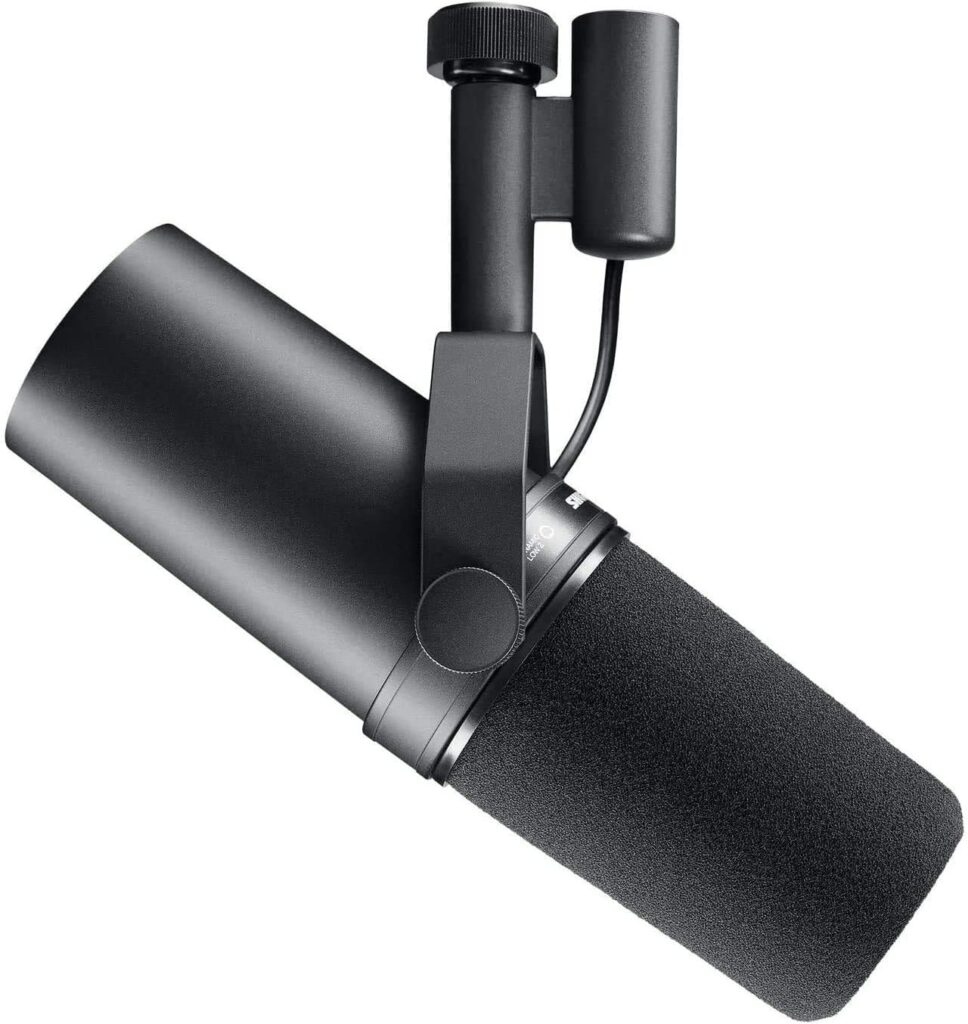
Pros
- Exceptional sound quality
- Superior build quality
- Widely used by professionals
- Excellent noise rejection
- Flat and wide frequency response
- Internal shock mount and pop filter
- Adjustable bass roll-off and presence boost
Cons
- Requires high-gain preamp
- High price point
- Hefty weight and size
- No built-in USB connection
- Learning curve for new users
| 28% DEAL ON AMAZON | CHECK LAZADA PHILIPPINES |
If you’re an experienced podcaster or just dipping your toes into the world of podcasting, the Shure SM7B is definitely a microphone that deserves your attention. It’s definitely an investment, but it can really take your sound to the next level and help you connect with your audience in a more meaningful way.
Think of the SM7B as your audio partner-in-crime. It’s the microphone that helps you tell your stories, share your ideas, and connect with your listeners on a genuine level. Its smooth, forgiving tone — a fancy way of stating that it makes practically everyone sound good — is what makes it famous. It manages to do all this while being incredibly tough and effortlessly tuning out the noise from your neighbor’s lawnmower or the sound of your computer fan.
Best for Aspiring Professional in a Treated Room
 Audio-Technica AT2020 (condenser)
Audio-Technica AT2020 (condenser)
The Audio-Technica AT2020 feels like that friendly, skilled buddy who’s always there to lend a hand. In the often-daunting world of microphones, the AT2020 really shines as a friendly introduction to professional audio, and still easy on the wallet.
This microphone isn’t about flashy gimmicks or over-the-top promises. It’s about delivering solid, reliable performance that noticeably upgrades your sound. Imagine it as the ideal launchpad for podcasters, musicians, and voice-over artists looking to elevate their recordings without jumping straight into high-end equipment just yet.
The AT2020 is known for its clear and natural sound reproduction. Compared to a simple headset or built-in laptop microphone, it records your speech with surprisingly high detail, giving you a more polished and presentable voice. This microphone really boosts your audio, giving your podcast that professional and engaging vibe right away.
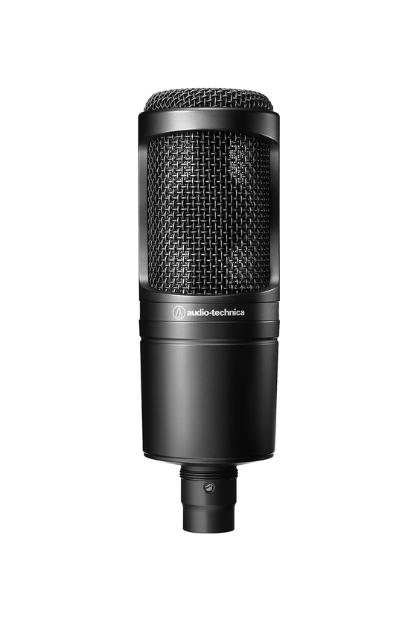
Pros
- Clear and natural sound
- Affordable price
- Solid build quality
- Compact and lightweight
- Versatility
- Wide frequency response
- Cardioid polar pattern
- Requires minimal setup
Cons
- Requires phantom power
- No built-in pop filter or shock mount
- Not ideal for noisy environments
- Limited features
- Less low-end response
| 20% DEAL ON AMAZON | CHECK LAZADA PHILIPPINES |
While it’s a condenser microphone, meaning it’s more sensitive to sound and detail, it’s not overly picky about its environment. Sure, a quiet, treated room is always ideal, but the AT2020 can still deliver great results even if your recording space is less than perfect.
So, if you’re looking for a microphone that’s affordable, easy to use, and a significant step up from your current setup, the Audio-Technica AT2020 might just be your ideal match.
Focusrite Scarlett Solo USB Audio Interface (4th Generation)
| CHECK STOCK ON AMAZON | CHECK STOCK ON AMAZON |
Consider the Scarlett Solo an ideal sidekick for the SM7dB. It’s compact, it’s stylish, and most importantly, it’s got enough clean gain to let the SM7dB truly sing, especially useful for those who maybe don’t need the extra boost and would prefer using the SM7dB in bypass mode. The Solo is known for its crystal-clear preamps, which means it takes that beautiful, warm sound from the microphone and delivers it to your computer with stunning clarity.
The beauty of this combo is its simplicity. You don’t need a ton of technical know-how to get up and running. It’s practically plug-and-play, which is perfect for those of us who want to focus on creating content, not fiddling with complicated settings.
Best for Enthusiasts and Professionals
 Shure SM7dB (dynamic)
Shure SM7dB (dynamic)
So you’ve heard of the legendary Shure SM7B, right? The microphone that’s practically a staple in the podcasting world? Well, imagine that iconic mic got a cool new upgrade: that’s the Shure SM7dB in a nutshell!
When I first heard about the Shure SM7dB, I was intrigued — it’s like the iconic SM7B we all know and love but with a modern twist. If you’ve ever wished for the rich, smooth sound of the SM7B without needing a separate preamp to crank up the gain, the SM7dB has you covered. It’s got a built-in preamp that simplifies your setup while still delivering that same legendary audio quality.
Think of it this way: the SM7dB is like the SM7B’s younger sibling who went and got a really handy superpower. It’s got all the same DNA – that warm, rich sound, the rugged build, the amazing ability to ignore background noise – but with a built-in preamp that gives it a major boost.
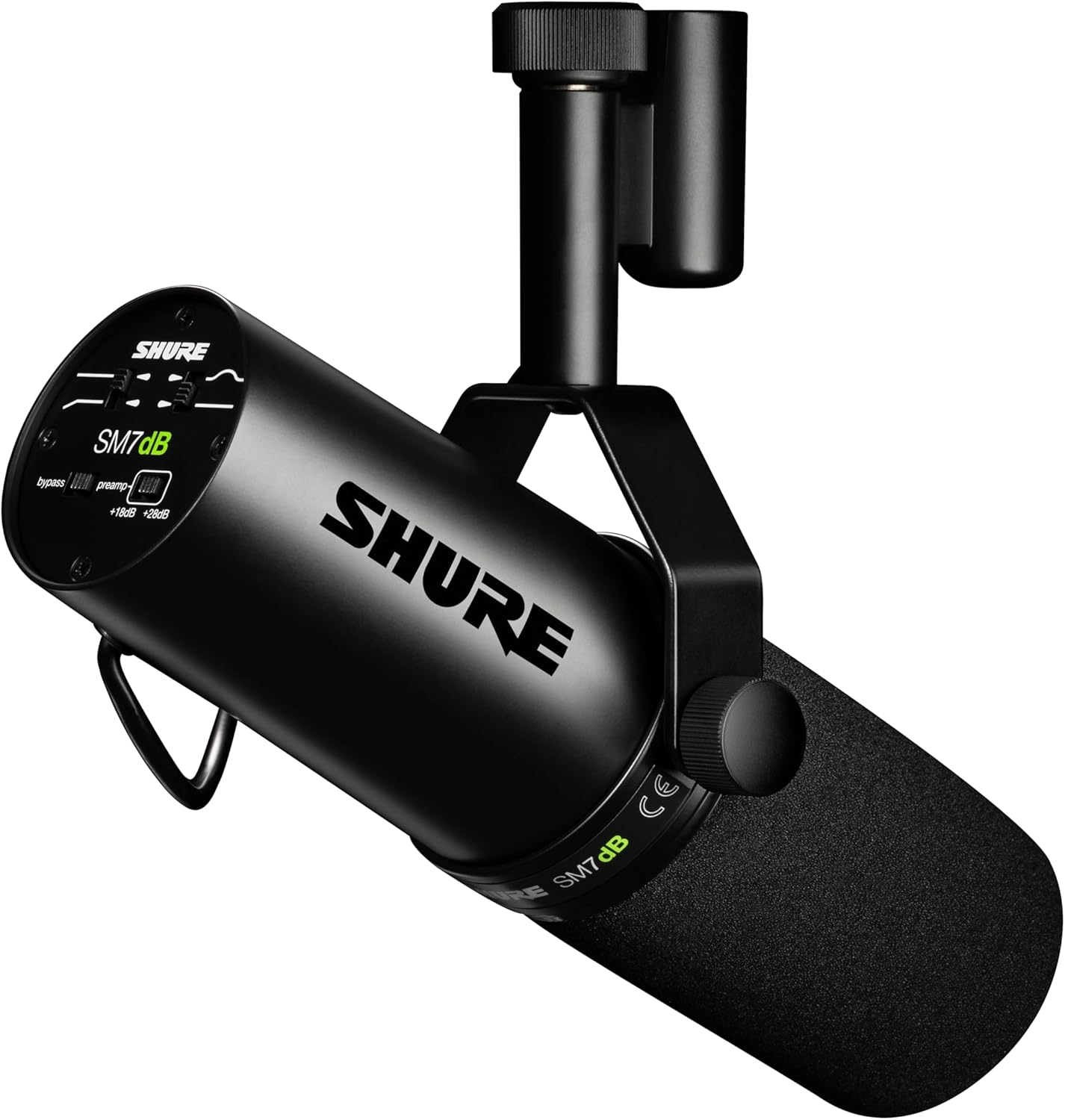
Pros
- Built-in preamp
- Exceptional sound quality
- Superior noise rejection
- Integrated shock mount and pop filter
- Durable build
- Flat and adjustable frequency response
- Electromagnetic hum shielding
- Improved usability
- Bypass switch for preamp
Cons
- Pricey
- Bulky and heavy
- Requires phantom power for the preamp
- No USB option
- Steeper learning curve for beginners
| CHECK STOCK ON AMAZON | CHECK LAZADA PHILIPPINES |
What’s the big deal with a built-in preamp, you ask? Well, the classic SM7B is known for being a bit “gain hungry,” meaning it needs a powerful audio interface to perform at its best. What about the SM7dB? Because it has that extra oomph built in, it’s easier to use with a greater variety of interfaces and provides a stronger, clearer signal right away.
The SM7dB’s built in preamp means you will likely not need an additional booster with the Focusrite Scarlett Solo, even when using the mic in bypass mode.
Basically, Shure took everything we love about the SM7B and made it even more convenient and user-friendly. If you loved the idea of the SM7B but were worried about needing extra gear to power it, the SM7dB might just be your dream microphone.
Best for Budget-Conscious Beginner
 Rode PodMic (dynamic)
Rode PodMic (dynamic)
If you’re on the hunt for a podcasting microphone that’s tough, excellent output, and doesn’t cost a fortune, well, you should definitely check out the Rode PodMic . This little guy is seriously punching above its weight.
First off, the PodMic is built like a miniature tank. We’re talking all-metal construction that feels solid and dependable. This isn’t some flimsy piece of plastic; it’s a microphone that’s ready to handle the bumps and bruises of a busy podcasting life.
But it’s not just about looks. The PodMic delivers a rich, broadcast-quality sound that’s surprisingly clear and detailed for its price. Think of it as having that classic, warm radio voice, but without needing to spend a ton of money to get it.
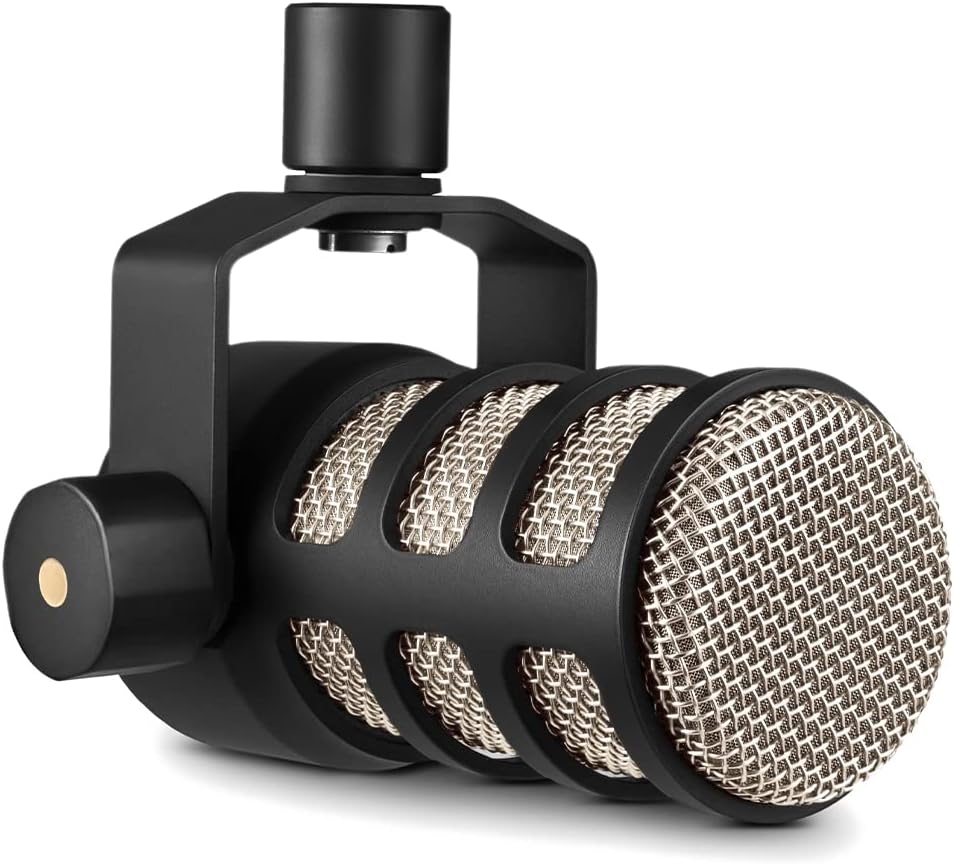
Pros
- Affordable price
- Durable build
- Excellent sound quality for spoken word
- Integrated pop filter
- Good noise rejection
- Compact design
- No phantom power required
Cons
- Requires a preamp
- Limited frequency response
- No onboard controls
- Heavier than expected
- No USB option
| 34% DEAL ON AMAZON | CHECK LAZADA PHILIPPINES |
The PodMic is specifically designed for podcasting. Rode really put some thought into what podcasters need, and it shows. It’s got a built-in pop filter to help tame those pesky plosives (those harsh “p” and “b” sounds), and it’s optimized to pick up your voice while minimizing background noise.
Best for On-the-Go Podcaster
 Shure MV7+ (dynamic)
Shure MV7+ (dynamic)
When I came across the Shure MV7+, I was instantly drawn to how it combines professional audio quality with modern-day convenience. Inspired by the legendary SM7B, this mic is designed for podcasters, streamers, and content creators who want exceptional sound without needing a complex setup. What sets the MV7+ apart is its dual connectivity — with both USB and XLR outputs, it’s ideal for people who are just starting out or who want to upgrade to a more advanced setup.
One thing I like about the MV7+ is how easy it is to use. Using the USB connection, you can dive into Shure’s user-friendly software, allowing you to adjust your sound with EQ settings and presets that fit your voice just right. Also, the built-in touch controls for gain, headphone volume, and mute are really easy to use. And let’s not forget its incredible ability to block out background noise, so your voice stays crisp and clear even in less-than-ideal environments.
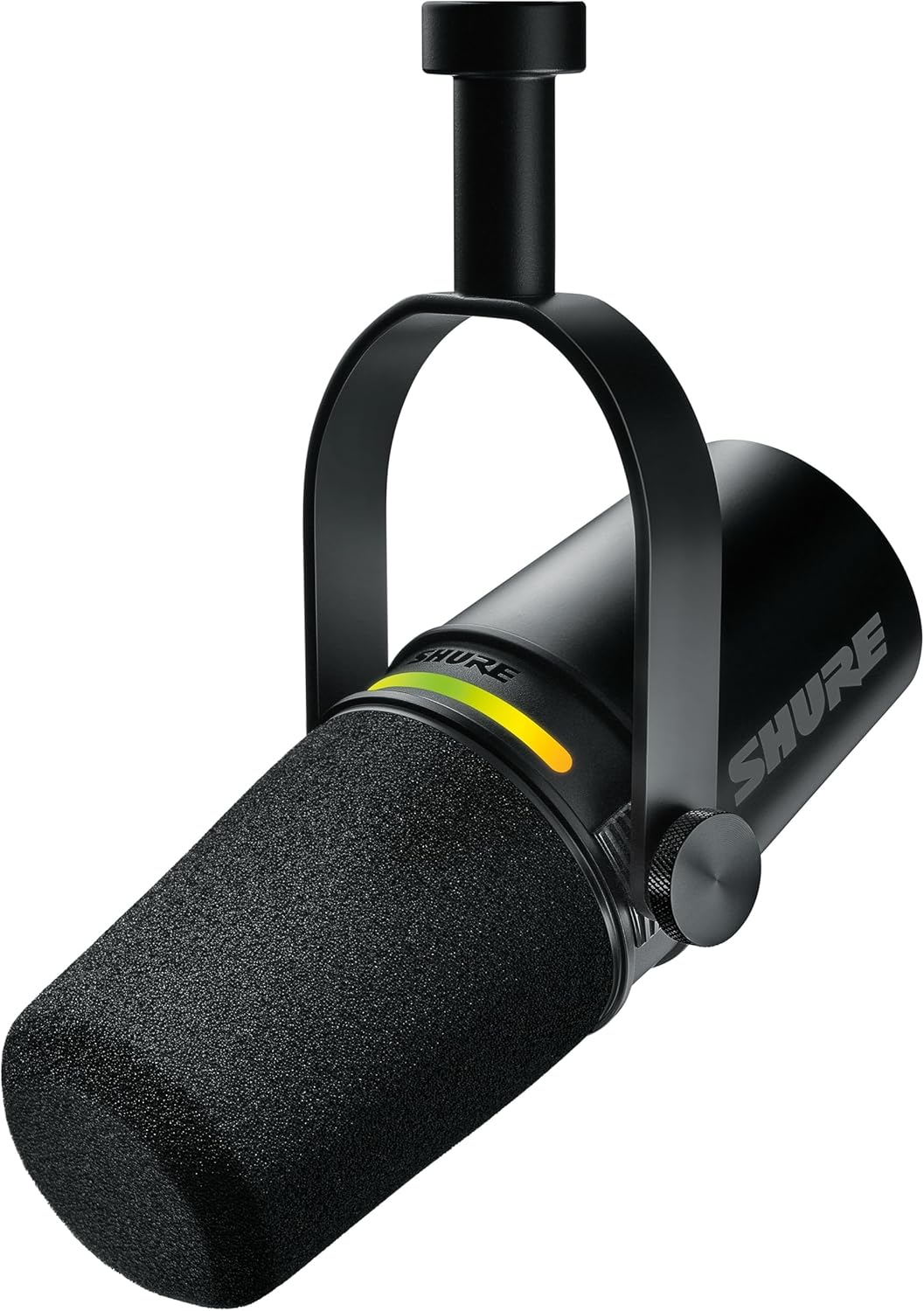
Pros
- Dual USB and XLR connectivity
- Improved sound quality
- Built-in headphone monitoring
- Touch controls for easy adjustments
- Built-In DSP (Digital Signal Processing)
- Durable build quality
- Excellent noise isolation
- Versatile mounting options
- Plug-and-play compatibility
- Integrated pop filter
Cons
- High price point
- Requires software for full features
- Heavy build
- Not fully analog with XLR
- Limited polar pattern
| 11% DEAL ON AMAZON | CHECK LAZADA PHILIPPINES |
Think of the MV7+ as the smarter, more versatile sibling of the original MV7. It keeps that signature Shure sound – warm, clear, and quite right for spoken word – but it adds a bunch of intelligent features that make your life as a podcaster way easier.
We’re talking about its customizable LED touch panel that’s not just about aesthetics (even though it does look pretty cool). It lets you mute your mic with a tap, adjust your levels on the go, and even monitor your audio in real-time. The MV7+ is packed with some really smart DSP (digital signal processing) that can automatically tweak your levels, cut down on background noise, and even help manage those annoying plosives.
Best for Interviewer
 Blue Yeti USB Microphone (condenser)
Blue Yeti USB Microphone (condenser)
The Blue Yeti is also a bit of a legend in the world of USB microphones. You’ve probably seen it on the desks of countless YouTubers, streamers, and, of course, podcasters. It’s that distinctive, retro-looking mic that just screams.
Why is the Blue Yeti such a hit among people? Well, it’s a combination of excellent sound quality, ease of use, and, most importantly, versatility. This isn’t a one-trick pony; it’s a microphone that can handle a wide range of recording situations, and it’s particularly well-suited for interviews. Thanks to its multiple polar patterns. The Yeti has a cool feature that lets you switch between different recording modes, each one made to capture sound from certain directions.
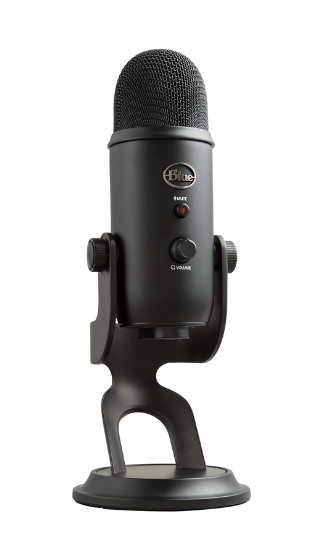
Pros
- Versatile polar patterns
- Affordable price for features
- Plug-and-play convenience
- High-auality audio
- Built-in gain control and mute button
- Headphone monitoring
- Sturdy build
- No need for external accessories
- Widely compatible
Cons
- Bulky design
- No XLR output
- Picks up background noise
- No advanced DSP features
- Fixed gain control
- Integrated stand can be limiting
- No dedicated software
| CHECK STOCK ON AMAZON | CHECK LAZADA PHILIPPINES |
The Blue Yeti is a USB microphone, meaning you just plug it directly into your computer and you’re ready to record. It’s super convenient, especially if you’re not looking to invest in a separate audio interface.
Best for Podcaster Who Also Records Music
 Rode NT1-A Signature Series (condenser)
Rode NT1-A Signature Series (condenser)
The Rode NT1-A is one of those microphones that quietly commands respect in the audio world. It’s not about flashy lights or crazy features; it’s about delivering exceptional sound quality, and that’s why it’s become a favorite for both podcasters and musicians.
The NT1-A is your go-to studio buddy, always prepared to jump in, whether you’re capturing an engaging podcast or creating some awesome music tracks. This is a large-diaphragm condenser microphone, which basically means it’s super sensitive and picks up a rich, detailed sound.
Why the NT1-A is a dream for podcasters who also dabble in music? The NT1-A is renowned for its incredibly low self-noise. What does that mean for you? It means your voice will be captured with stunning clarity, free from any annoying hiss or hum. It’s like a sonic magnifying glass for your vocals, ideal for both spoken word and singing.
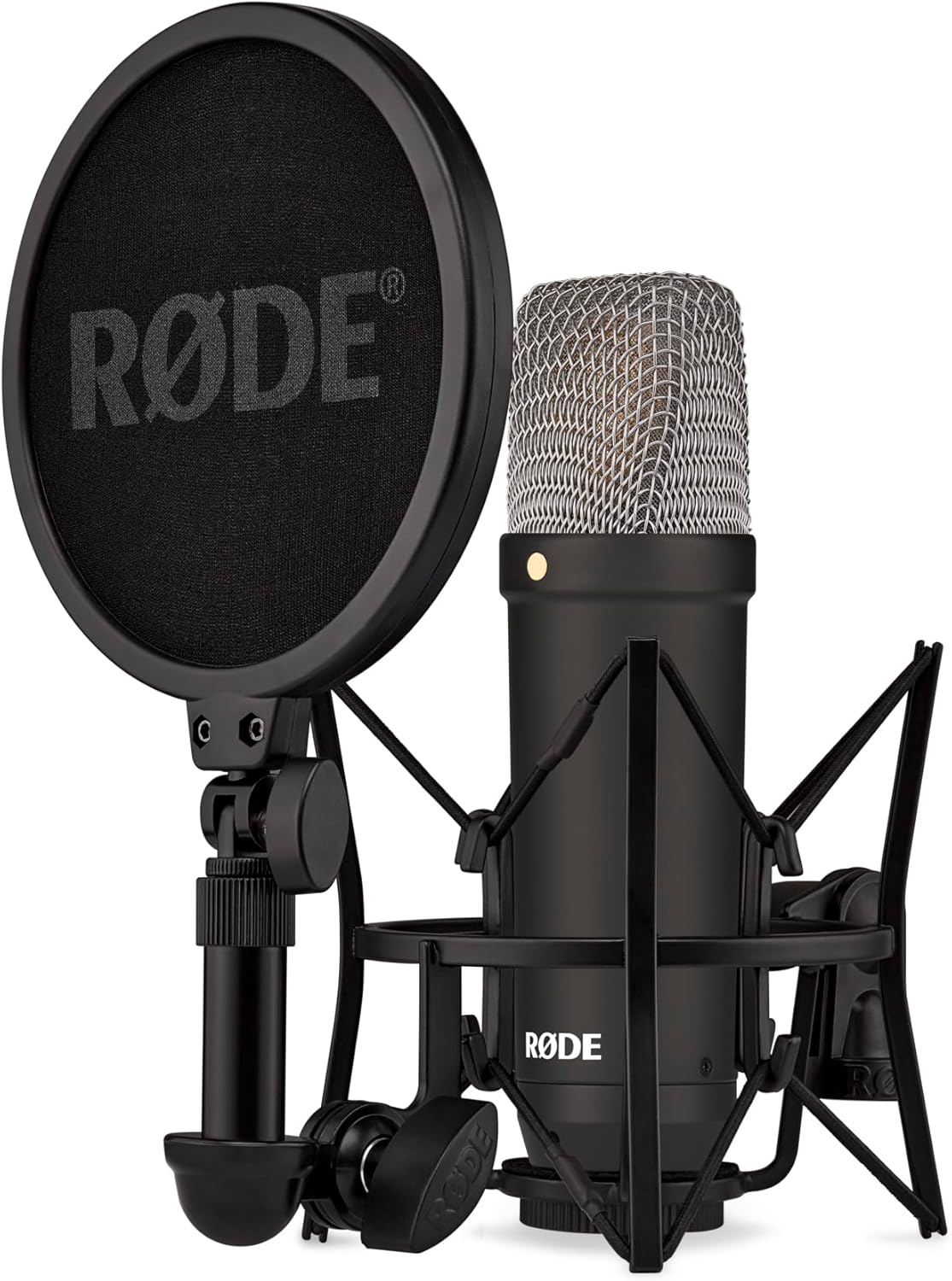
Pros
- Exceptional sound quality
- Low self-noise
- Durable build
- Affordable price
- Wide compatibility
- Included accessories
- Versatile use
- Highly sensitive
Cons
- Requires phantom power
- Picks up room noise
- Fixed cardioid pattern
- No onboard controls
- Not portable
- Limited dynamic range for loud sources
| CHECK STOCK ON AMAZON | CHECK LAZADA PHILIPPINES |
While it excels at capturing vocals, the NT1-A is no slouch when it comes to recording instruments. Pianos, acoustic guitars, and a variety of other instruments benefit greatly from its broad frequency response and rich tone. So, you can totally record your podcast intro music and then add in some vocal tracks, all using the same microphone. Pretty convenient, right?
Rode microphones are known for their solid construction, and the NT1-A definitely lives up to that reputation.. It’s a durable piece of gear that’s designed to withstand the demands of a home studio. Now, the NT1-A is an XLR microphone, so you will need an audio interface to connect it to your computer. But trust me, the extra bit of setup is well worth it for the sound quality you’ll get.
Best for Gamers
 HyperX QuadCast (condenser)
HyperX QuadCast (condenser)
Let’s talk about the elephant in the room: that eye-catching red shock mount and the customizable RGB lighting on the QuadCast S model (newest model).
The HyperX QuadCast looks fantastic and gives your game setup a stylish look. It also provides crystal-clear audio that helps your voice stand out during streams or team conversations. This mic really gives off a professional vibe, yet it’s incredibly user-friendly.
One of my favorite features is the tap-to-mute sensor — it’s quick, intuitive, plus the LED indicator clearly shows when your mic is on or off (no more awkward hot-mic moments). That built-in anti-vibration shock mount isn’t just for show. It really helps to reduce unwanted noise from your gaming mouse, keyboard, or even just enthusiastic desk-pounding during intense gaming sessions.
Just like the Blue Yeti, the QuadCast offers four selectable polar patterns: stereo, omnidirectional, cardioid, and bidirectional. It’s very flexible in this way, so you can use it to stream alone, play games with other people, or even record a podcast.
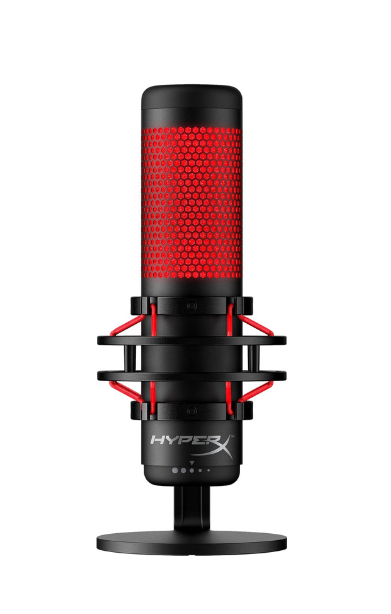
Pros
- Eye-catching design
- High-quality sound
- Multiple polar patterns
- Built-in pop filter
- Convenient tap-to-mute sensor
- Real-time monitoring
- Integrated shock mount
- Easy setup
- Adjustable gain control
- Lightweight and portable
Cons
- High sensitivity
- USB-only connectivity
- Limited software features
- RGB may not appeal to everyone
| CHECK STOCK ON AMAZON | CHECK LAZADA PHILIPPINES |
It’s a USB microphone, so you can simply plug it into your PC or console and start streaming. No complicated setup required.
If you’re serious about gaming and streaming, the HyperX QuadCast doesn’t just enhance your sound; it elevates your entire setup. It really brings together style, functionality, and features that gamers will love which make it a standout choice for anyone looking to level up their audio game.
The HyperX QuadCast S RGB model
| CHECK STOCK ON AMAZON | CHECK LAZADA PHILIPPINES |
Best for Live Vocal Performances
 Shure SM58
Shure SM58
The SM58 Pro is a gold standard for live vocals, whether on stage or in a rehearsal setting. Its cardioid polar pattern minimizes background noise and feedback, focusing on the performer’s voice and delivering clear and warm audio even in loud environments.
It is like the trusty old friend every performer and audio enthusiast needs. It’s been a favorite for years, and you can totally understand why.
I really appreciate how dependable the SM58 is. It has a cardioid pattern that really hones in on your voice and keeps out all that distracting background noise. This way, you come across sounding clear and professional, even when things get a bit noisy around you. Also, it’s super sturdy, designed to take drops, rough handling, and outdoor gigs without any issues. Oh, and we can’t overlook the built-in pop filter! It really helps keep your audio nice and smooth by cutting down on those plosive sounds like “P” and “B.”
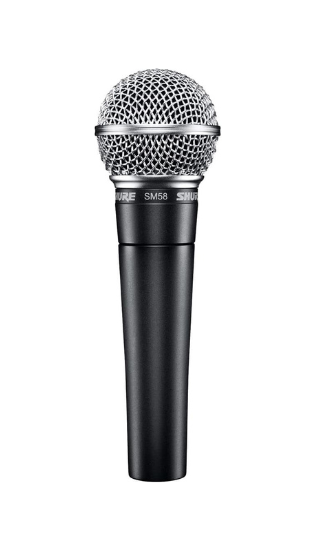
Pros
- Excellent for live vocals
- Legendary durability
- Excellent feedback rejection
- Built-in pop filter
- Affordable and reliable
- Versatility
- Low handling noise
- Wide compatibility
- Proven track record as industry standard
Cons
- Limited frequency range
- Not ideal for studio use
- Requires preamp with sufficient gain
- Bulky for some users
- No onboard controls
| CHECK STOCK ON AMAZON | CHECK LAZADA PHILIPPINES |
If you’re looking for a microphone that’s durable, versatile, and delivers consistent performance, the Shure SM58 is a no-brainer. It’s a classic that never disappoints.
Must Read: Tech Essentials Guide in 2024: Gadgets Every Enthusiast Needs
The Bottom Line
Audio quality really is the most important thing when it comes to podcasting. A good podcasting microphone is more than just a tool; it’s the core of your show that makes sure every word you say is heard clearly and fully.
Choosing the right microphone is a journey of understanding your needs, your recording environment, and your budget. Feel free to try things out, check out reviews, and give those audio samples a listen. What matters most when choosing a microphone for your podcast is how well it brings out your voice and how well it allows you to connect with your listeners.
Either which microphone you choose, remember that content is king. A high-quality microphone will enhance your voice, but your passion, knowledge, and authenticity are what truly captivate your audience.
Happy podcasting!
Frequently Asked Questions: (FAQs)
Should I choose a USB or XLR microphone for podcasting?
-
- USB Microphones: Convenient and plug-and-play, ideal for beginners or solo podcasters.
- XLR Microphones: Offer better audio quality and more control, preferred by professionals but require an audio interface or mixer.
What polar pattern is best for podcasting?
-
- The cardioid polar pattern is most common for podcasting as it focuses on sound directly in front of the microphone while rejecting noise from the sides and rear.
Are dynamic microphones better for podcasting?
-
- Dynamic microphones are often better for:
- Noisy environments: They are less sensitive to background noise.
- Untreated rooms: They capture less ambient sound than condenser microphones.
- Dynamic microphones are often better for:
Are condenser microphones good for podcasting?
-
- Yes, if you have a treated recording space. Condenser microphones offer:
- Detailed audio: Excellent for capturing subtle nuances in voice.
- Wide frequency response: Makes voices sound rich and natural.
- Yes, if you have a treated recording space. Condenser microphones offer:
Do I need a microphone with built-in pop filters for podcasting?
-
- A built-in pop filter is helpful to reduce plosive sounds (like “P” and “B”), but external pop filters are inexpensive and work just as well if your microphone doesn’t have one.
How important is a shock mount for podcasting microphones?
-
- A shock mount is crucial for reducing vibrations and handling noise, especially if your microphone is sensitive to movement or mounted on a desk stand.
Can I use a headset microphone for podcasting?
-
- While you can use a headset microphone, they generally do not provide the same audio quality as dedicated podcasting microphones. They are better suited for casual or mobile recordings.
Do I need phantom power for podcasting microphones?
-
- Phantom power (+48V) is required for condenser microphones but not for dynamic microphones.
- If your microphone requires phantom power, make sure your audio interface or mixer can supply it.
Is it better to use a desktop stand or a boom arm for podcasting microphones?
-
- A boom arm is generally better as it:
- Frees up desk space.
- Allows precise positioning.
- Reduces desk vibrations compared to a desktop stand.
- A boom arm is generally better as it:
Should I prioritize audio quality or convenience?
-
- For beginners or solo podcasters, prioritize convenience (e.g., USB microphones).
- For professionals or collaborative podcasts, prioritize audio quality with an XLR setup.

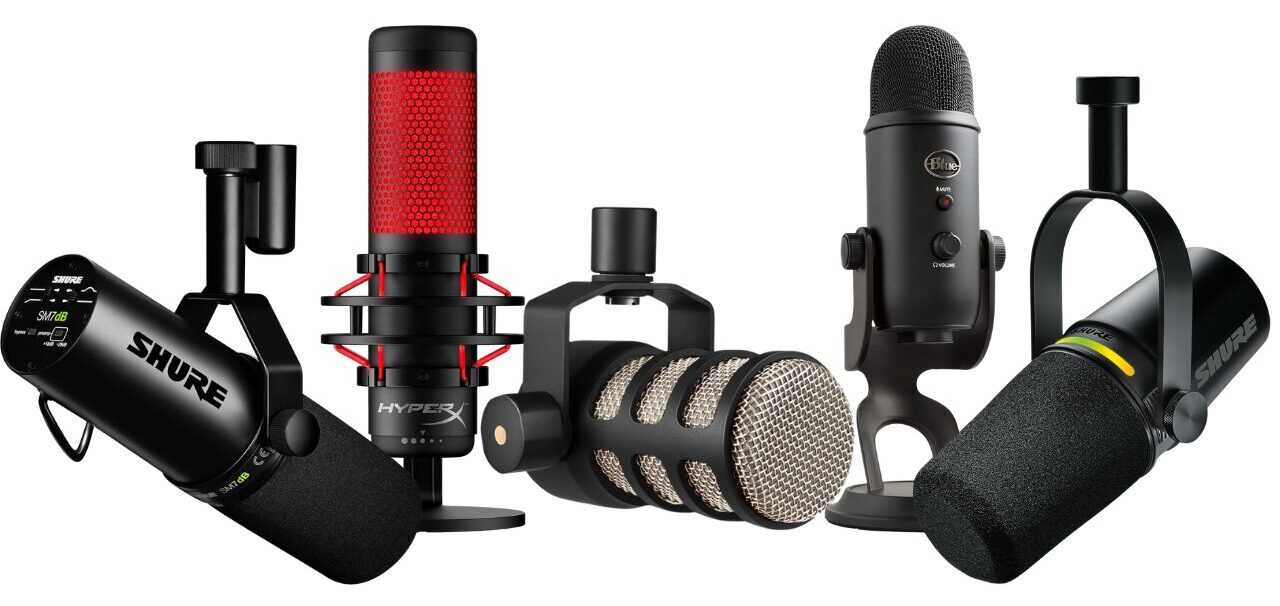
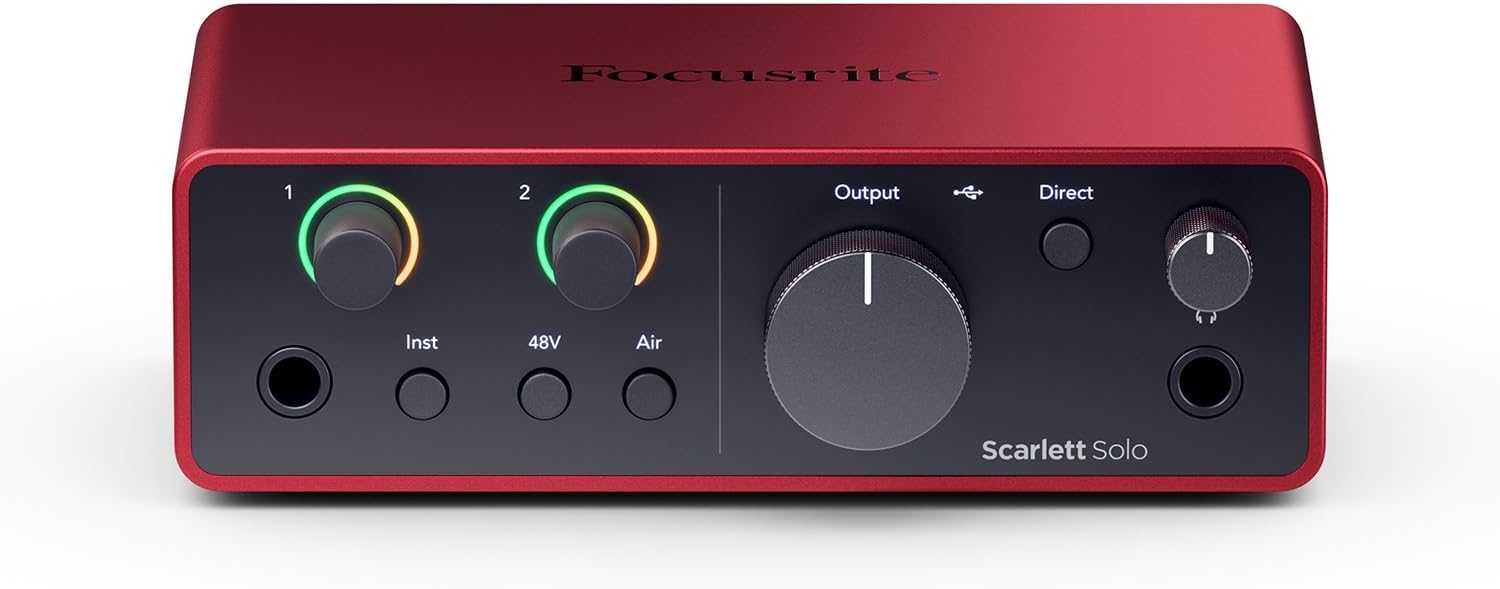
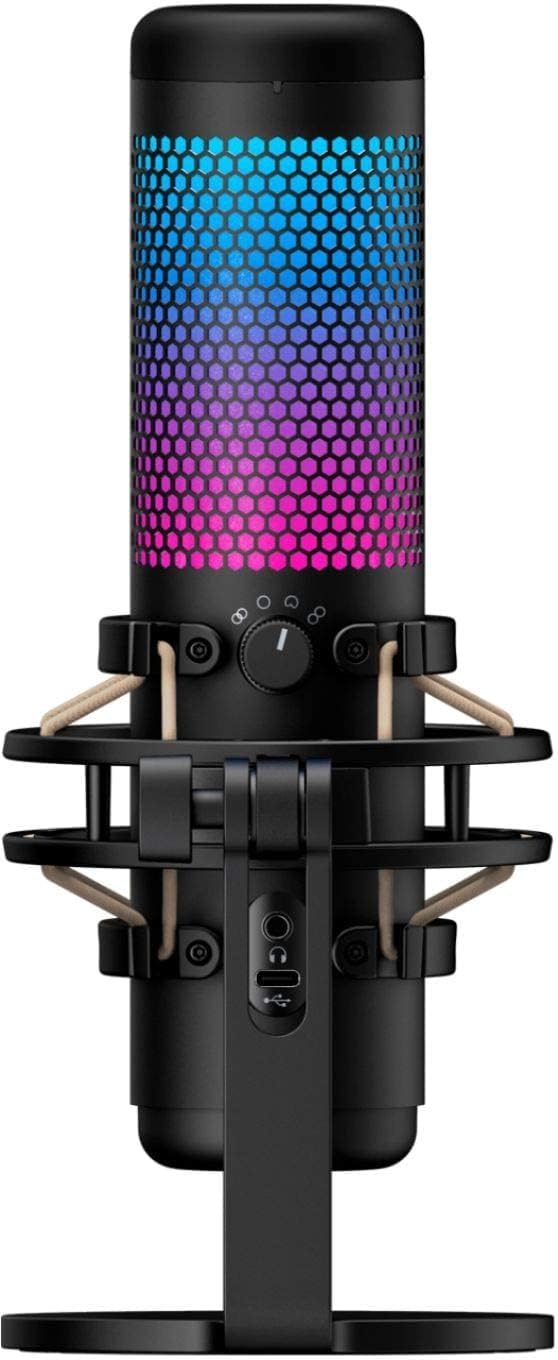
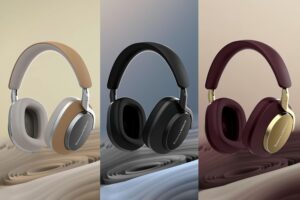
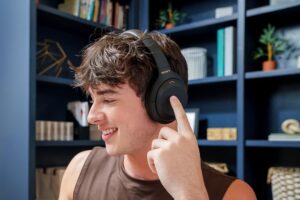
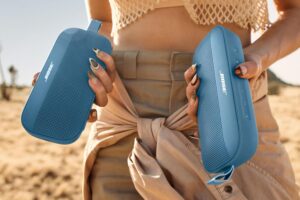
Add Comment